Understanding Financial Terms and their Impact on Cash Flow
VerifiedAdded on 2023/01/10
|13
|3124
|50
AI Summary
This report explains important financial terms like profit, cash flow, and working capital, and examines the impact of changes in working capital on cash flow. It provides recommendations for improving cash flow.
Contribute Materials
Your contribution can guide someone’s learning journey. Share your
documents today.
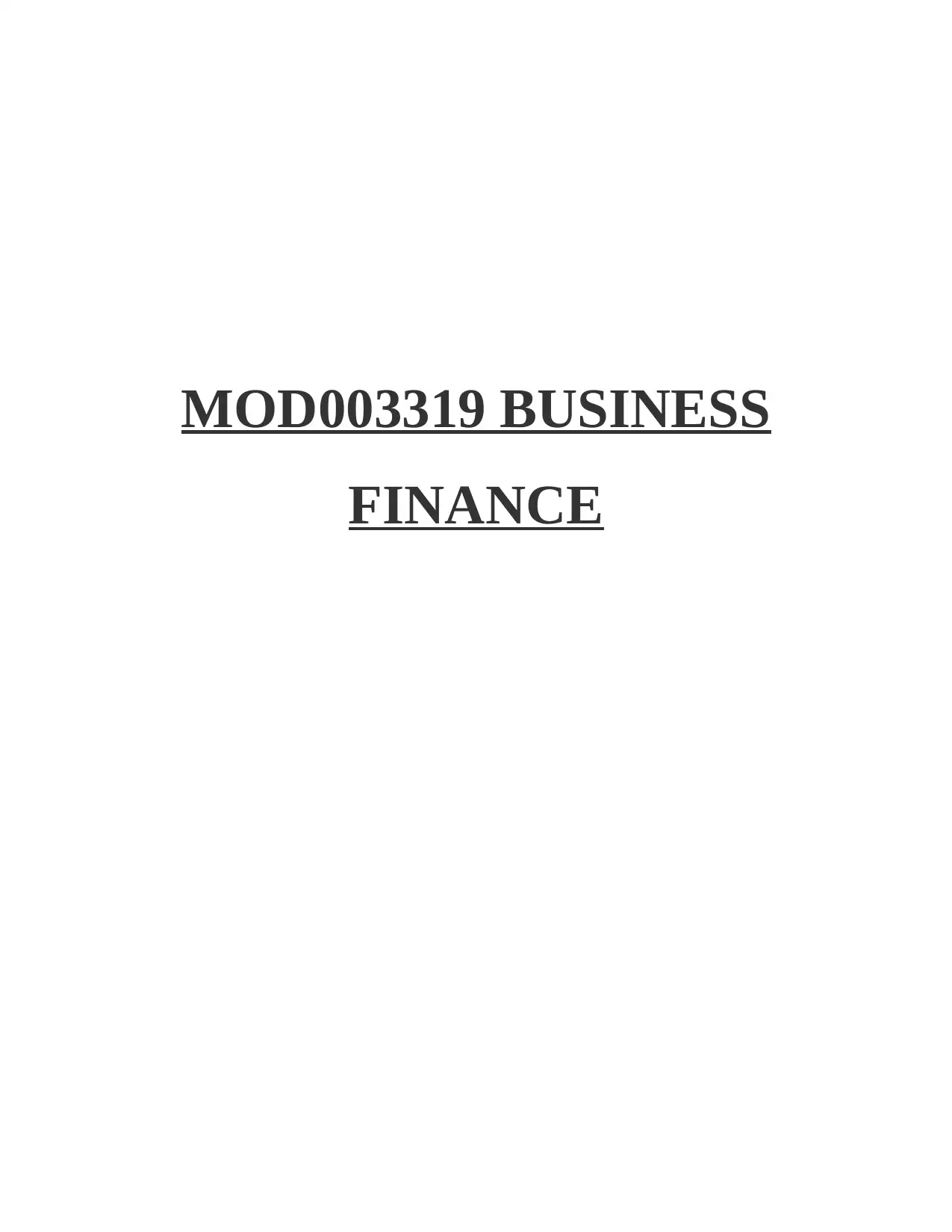
MOD003319 BUSINESS
FINANCE
FINANCE
Secure Best Marks with AI Grader
Need help grading? Try our AI Grader for instant feedback on your assignments.
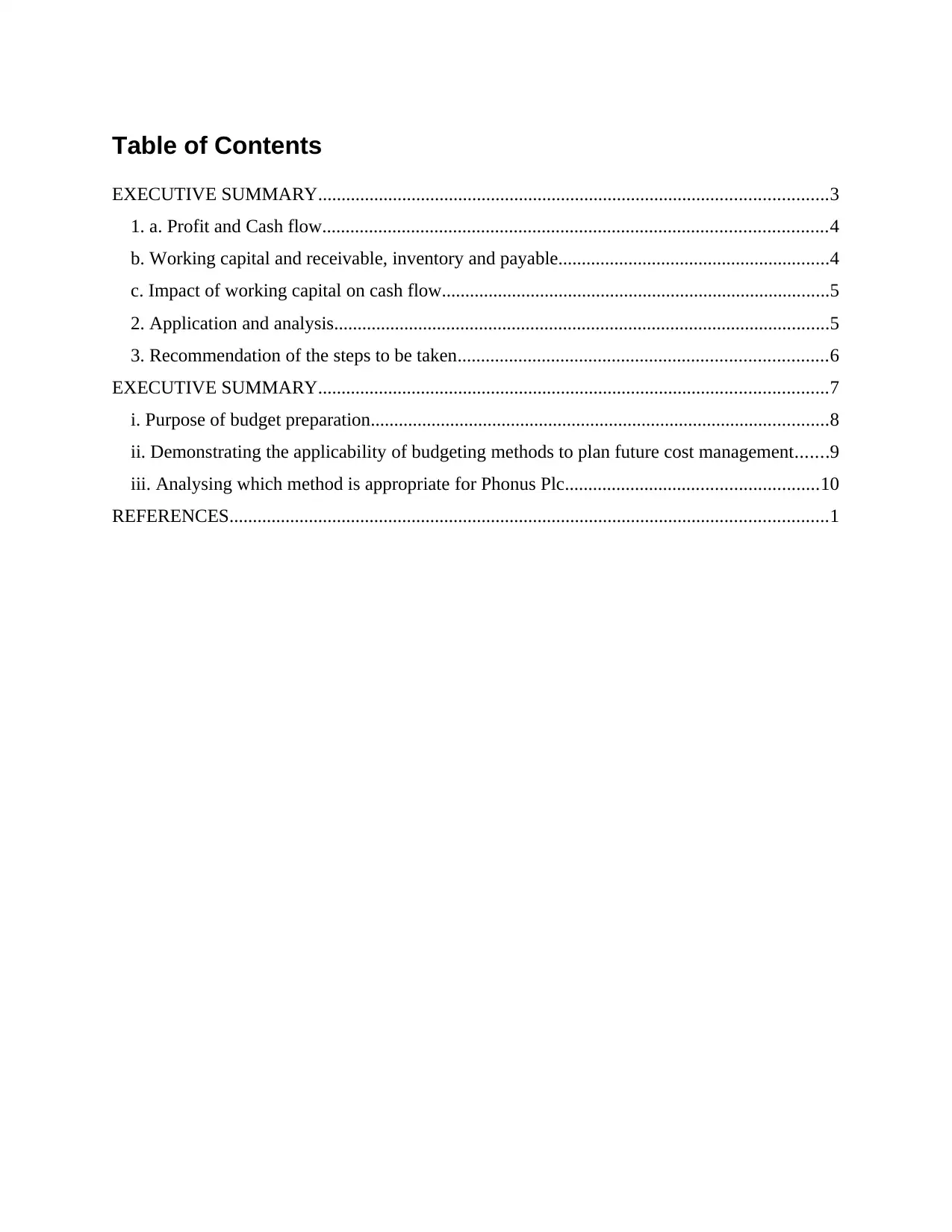
Table of Contents
EXECUTIVE SUMMARY.............................................................................................................3
1. a. Profit and Cash flow............................................................................................................4
b. Working capital and receivable, inventory and payable..........................................................4
c. Impact of working capital on cash flow...................................................................................5
2. Application and analysis..........................................................................................................5
3. Recommendation of the steps to be taken...............................................................................6
EXECUTIVE SUMMARY.............................................................................................................7
i. Purpose of budget preparation..................................................................................................8
ii. Demonstrating the applicability of budgeting methods to plan future cost management.......9
iii. Analysing which method is appropriate for Phonus Plc......................................................10
REFERENCES................................................................................................................................1
EXECUTIVE SUMMARY.............................................................................................................3
1. a. Profit and Cash flow............................................................................................................4
b. Working capital and receivable, inventory and payable..........................................................4
c. Impact of working capital on cash flow...................................................................................5
2. Application and analysis..........................................................................................................5
3. Recommendation of the steps to be taken...............................................................................6
EXECUTIVE SUMMARY.............................................................................................................7
i. Purpose of budget preparation..................................................................................................8
ii. Demonstrating the applicability of budgeting methods to plan future cost management.......9
iii. Analysing which method is appropriate for Phonus Plc......................................................10
REFERENCES................................................................................................................................1
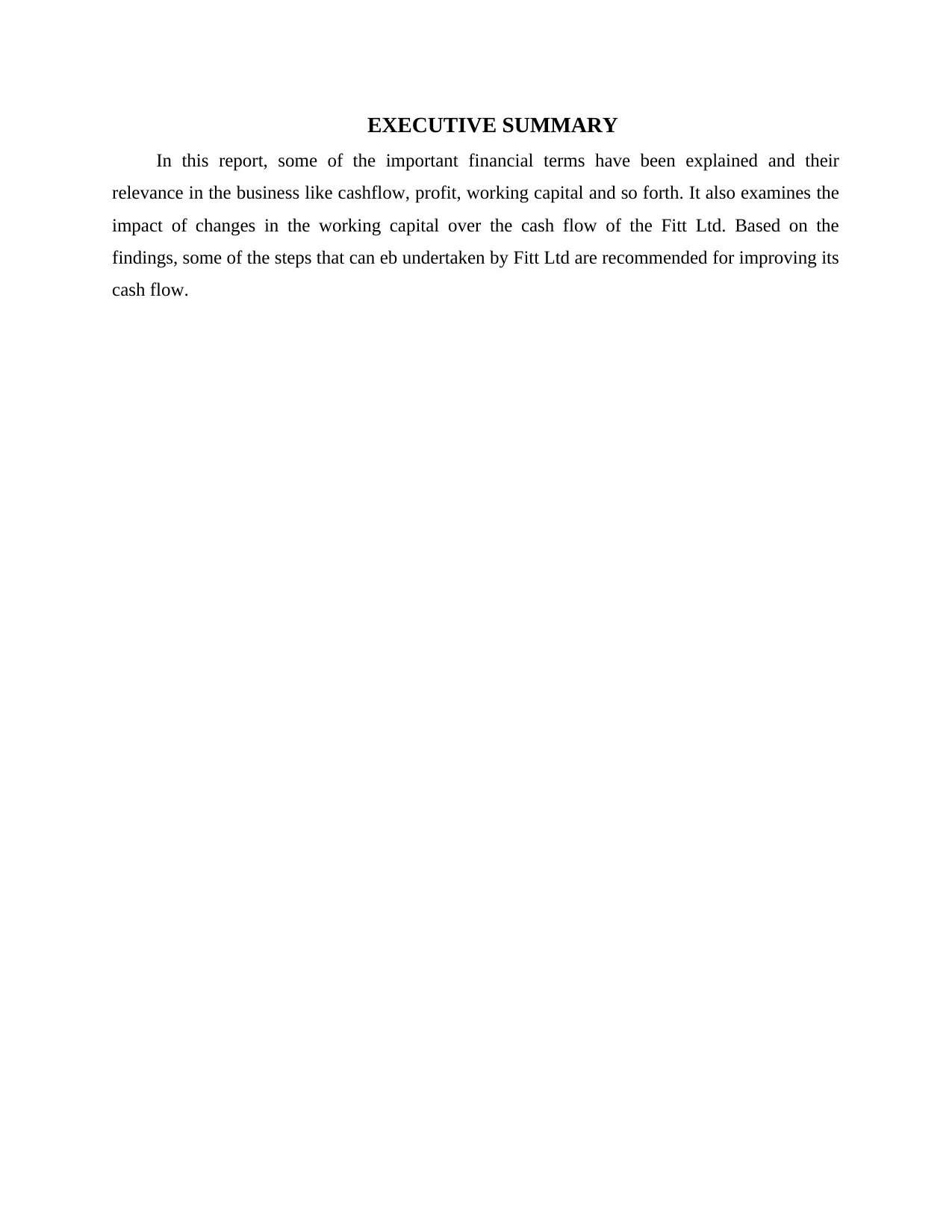
EXECUTIVE SUMMARY
In this report, some of the important financial terms have been explained and their
relevance in the business like cashflow, profit, working capital and so forth. It also examines the
impact of changes in the working capital over the cash flow of the Fitt Ltd. Based on the
findings, some of the steps that can eb undertaken by Fitt Ltd are recommended for improving its
cash flow.
In this report, some of the important financial terms have been explained and their
relevance in the business like cashflow, profit, working capital and so forth. It also examines the
impact of changes in the working capital over the cash flow of the Fitt Ltd. Based on the
findings, some of the steps that can eb undertaken by Fitt Ltd are recommended for improving its
cash flow.
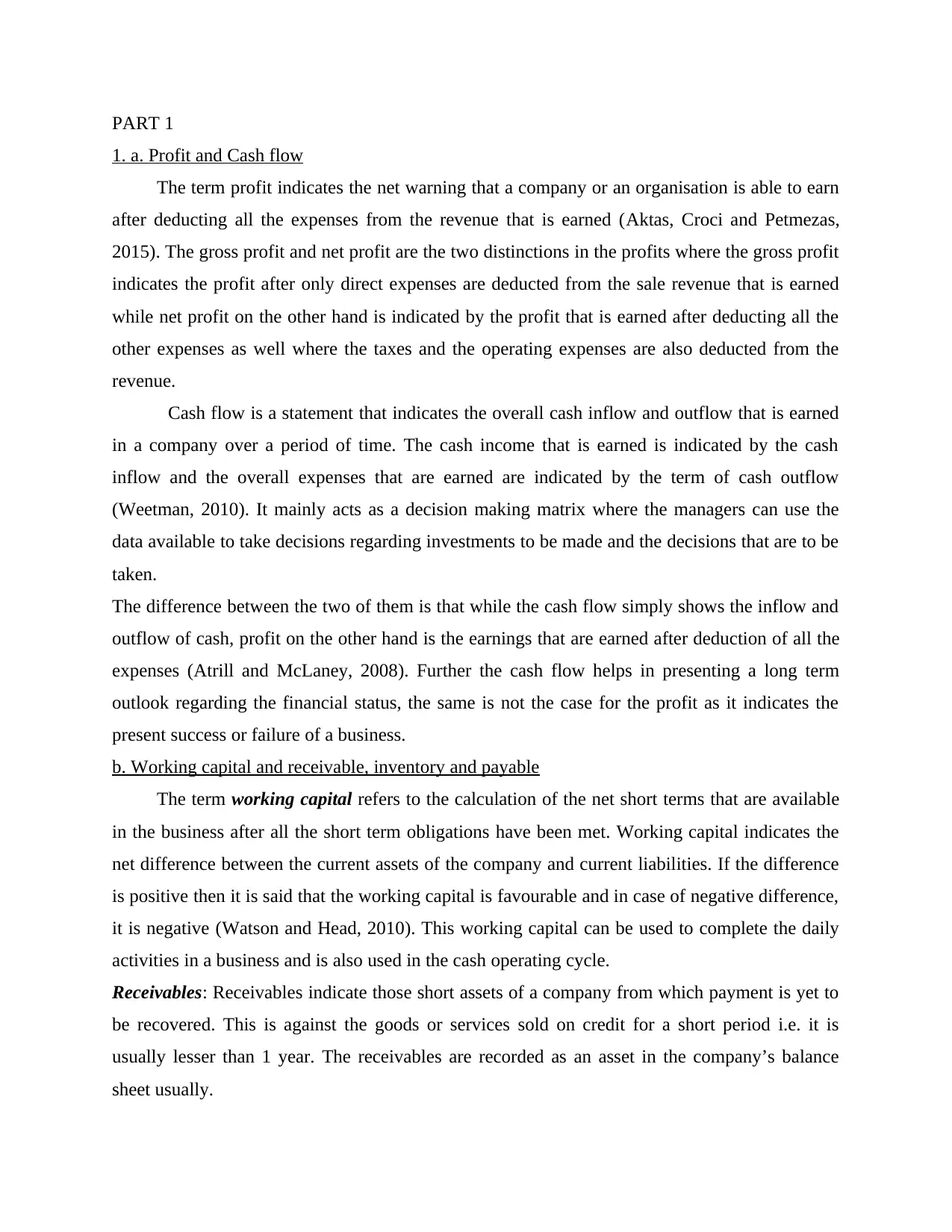
PART 1
1. a. Profit and Cash flow
The term profit indicates the net warning that a company or an organisation is able to earn
after deducting all the expenses from the revenue that is earned (Aktas, Croci and Petmezas,
2015). The gross profit and net profit are the two distinctions in the profits where the gross profit
indicates the profit after only direct expenses are deducted from the sale revenue that is earned
while net profit on the other hand is indicated by the profit that is earned after deducting all the
other expenses as well where the taxes and the operating expenses are also deducted from the
revenue.
Cash flow is a statement that indicates the overall cash inflow and outflow that is earned
in a company over a period of time. The cash income that is earned is indicated by the cash
inflow and the overall expenses that are earned are indicated by the term of cash outflow
(Weetman, 2010). It mainly acts as a decision making matrix where the managers can use the
data available to take decisions regarding investments to be made and the decisions that are to be
taken.
The difference between the two of them is that while the cash flow simply shows the inflow and
outflow of cash, profit on the other hand is the earnings that are earned after deduction of all the
expenses (Atrill and McLaney, 2008). Further the cash flow helps in presenting a long term
outlook regarding the financial status, the same is not the case for the profit as it indicates the
present success or failure of a business.
b. Working capital and receivable, inventory and payable
The term working capital refers to the calculation of the net short terms that are available
in the business after all the short term obligations have been met. Working capital indicates the
net difference between the current assets of the company and current liabilities. If the difference
is positive then it is said that the working capital is favourable and in case of negative difference,
it is negative (Watson and Head, 2010). This working capital can be used to complete the daily
activities in a business and is also used in the cash operating cycle.
Receivables: Receivables indicate those short assets of a company from which payment is yet to
be recovered. This is against the goods or services sold on credit for a short period i.e. it is
usually lesser than 1 year. The receivables are recorded as an asset in the company’s balance
sheet usually.
1. a. Profit and Cash flow
The term profit indicates the net warning that a company or an organisation is able to earn
after deducting all the expenses from the revenue that is earned (Aktas, Croci and Petmezas,
2015). The gross profit and net profit are the two distinctions in the profits where the gross profit
indicates the profit after only direct expenses are deducted from the sale revenue that is earned
while net profit on the other hand is indicated by the profit that is earned after deducting all the
other expenses as well where the taxes and the operating expenses are also deducted from the
revenue.
Cash flow is a statement that indicates the overall cash inflow and outflow that is earned
in a company over a period of time. The cash income that is earned is indicated by the cash
inflow and the overall expenses that are earned are indicated by the term of cash outflow
(Weetman, 2010). It mainly acts as a decision making matrix where the managers can use the
data available to take decisions regarding investments to be made and the decisions that are to be
taken.
The difference between the two of them is that while the cash flow simply shows the inflow and
outflow of cash, profit on the other hand is the earnings that are earned after deduction of all the
expenses (Atrill and McLaney, 2008). Further the cash flow helps in presenting a long term
outlook regarding the financial status, the same is not the case for the profit as it indicates the
present success or failure of a business.
b. Working capital and receivable, inventory and payable
The term working capital refers to the calculation of the net short terms that are available
in the business after all the short term obligations have been met. Working capital indicates the
net difference between the current assets of the company and current liabilities. If the difference
is positive then it is said that the working capital is favourable and in case of negative difference,
it is negative (Watson and Head, 2010). This working capital can be used to complete the daily
activities in a business and is also used in the cash operating cycle.
Receivables: Receivables indicate those short assets of a company from which payment is yet to
be recovered. This is against the goods or services sold on credit for a short period i.e. it is
usually lesser than 1 year. The receivables are recorded as an asset in the company’s balance
sheet usually.
Secure Best Marks with AI Grader
Need help grading? Try our AI Grader for instant feedback on your assignments.
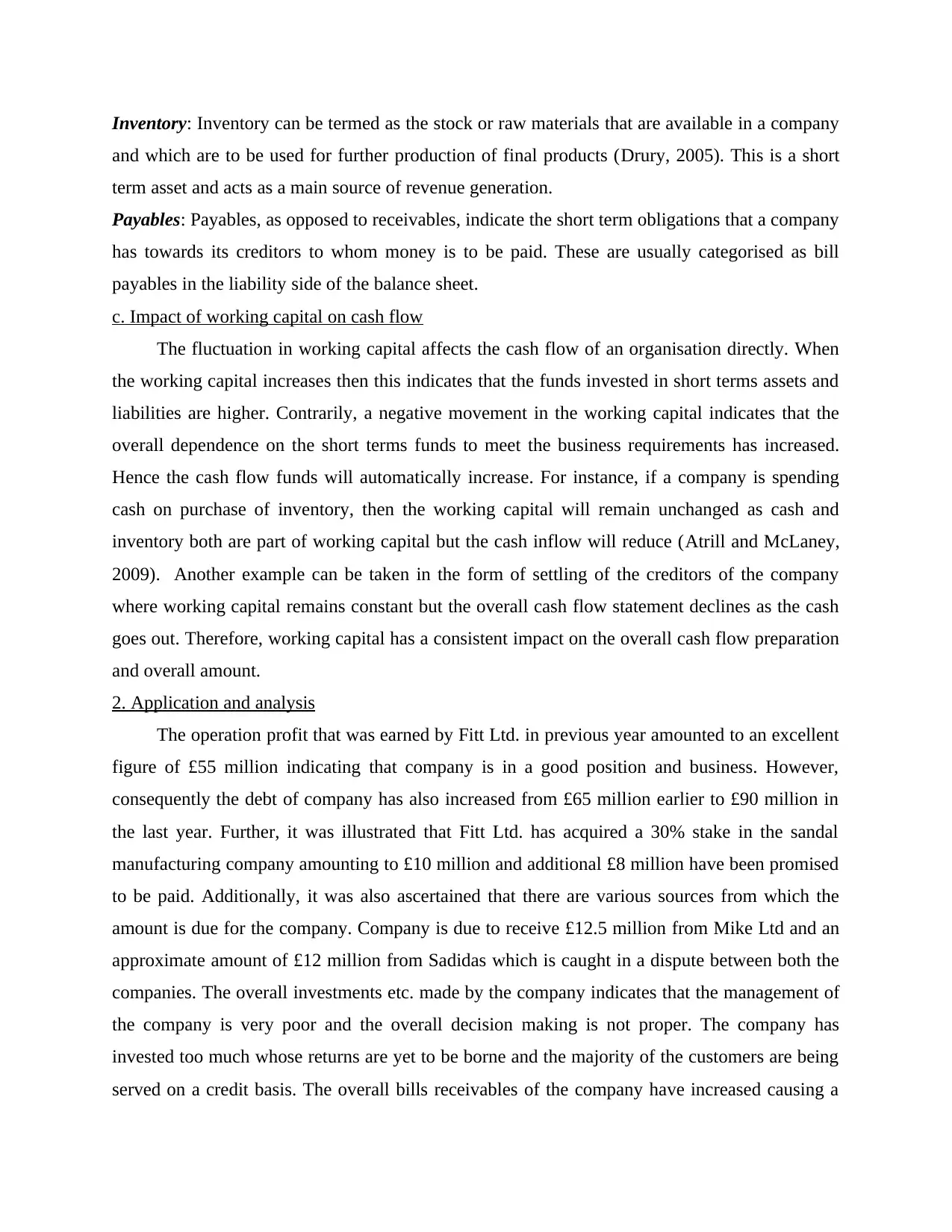
Inventory: Inventory can be termed as the stock or raw materials that are available in a company
and which are to be used for further production of final products (Drury, 2005). This is a short
term asset and acts as a main source of revenue generation.
Payables: Payables, as opposed to receivables, indicate the short term obligations that a company
has towards its creditors to whom money is to be paid. These are usually categorised as bill
payables in the liability side of the balance sheet.
c. Impact of working capital on cash flow
The fluctuation in working capital affects the cash flow of an organisation directly. When
the working capital increases then this indicates that the funds invested in short terms assets and
liabilities are higher. Contrarily, a negative movement in the working capital indicates that the
overall dependence on the short terms funds to meet the business requirements has increased.
Hence the cash flow funds will automatically increase. For instance, if a company is spending
cash on purchase of inventory, then the working capital will remain unchanged as cash and
inventory both are part of working capital but the cash inflow will reduce (Atrill and McLaney,
2009). Another example can be taken in the form of settling of the creditors of the company
where working capital remains constant but the overall cash flow statement declines as the cash
goes out. Therefore, working capital has a consistent impact on the overall cash flow preparation
and overall amount.
2. Application and analysis
The operation profit that was earned by Fitt Ltd. in previous year amounted to an excellent
figure of £55 million indicating that company is in a good position and business. However,
consequently the debt of company has also increased from £65 million earlier to £90 million in
the last year. Further, it was illustrated that Fitt Ltd. has acquired a 30% stake in the sandal
manufacturing company amounting to £10 million and additional £8 million have been promised
to be paid. Additionally, it was also ascertained that there are various sources from which the
amount is due for the company. Company is due to receive £12.5 million from Mike Ltd and an
approximate amount of £12 million from Sadidas which is caught in a dispute between both the
companies. The overall investments etc. made by the company indicates that the management of
the company is very poor and the overall decision making is not proper. The company has
invested too much whose returns are yet to be borne and the majority of the customers are being
served on a credit basis. The overall bills receivables of the company have increased causing a
and which are to be used for further production of final products (Drury, 2005). This is a short
term asset and acts as a main source of revenue generation.
Payables: Payables, as opposed to receivables, indicate the short term obligations that a company
has towards its creditors to whom money is to be paid. These are usually categorised as bill
payables in the liability side of the balance sheet.
c. Impact of working capital on cash flow
The fluctuation in working capital affects the cash flow of an organisation directly. When
the working capital increases then this indicates that the funds invested in short terms assets and
liabilities are higher. Contrarily, a negative movement in the working capital indicates that the
overall dependence on the short terms funds to meet the business requirements has increased.
Hence the cash flow funds will automatically increase. For instance, if a company is spending
cash on purchase of inventory, then the working capital will remain unchanged as cash and
inventory both are part of working capital but the cash inflow will reduce (Atrill and McLaney,
2009). Another example can be taken in the form of settling of the creditors of the company
where working capital remains constant but the overall cash flow statement declines as the cash
goes out. Therefore, working capital has a consistent impact on the overall cash flow preparation
and overall amount.
2. Application and analysis
The operation profit that was earned by Fitt Ltd. in previous year amounted to an excellent
figure of £55 million indicating that company is in a good position and business. However,
consequently the debt of company has also increased from £65 million earlier to £90 million in
the last year. Further, it was illustrated that Fitt Ltd. has acquired a 30% stake in the sandal
manufacturing company amounting to £10 million and additional £8 million have been promised
to be paid. Additionally, it was also ascertained that there are various sources from which the
amount is due for the company. Company is due to receive £12.5 million from Mike Ltd and an
approximate amount of £12 million from Sadidas which is caught in a dispute between both the
companies. The overall investments etc. made by the company indicates that the management of
the company is very poor and the overall decision making is not proper. The company has
invested too much whose returns are yet to be borne and the majority of the customers are being
served on a credit basis. The overall bills receivables of the company have increased causing a
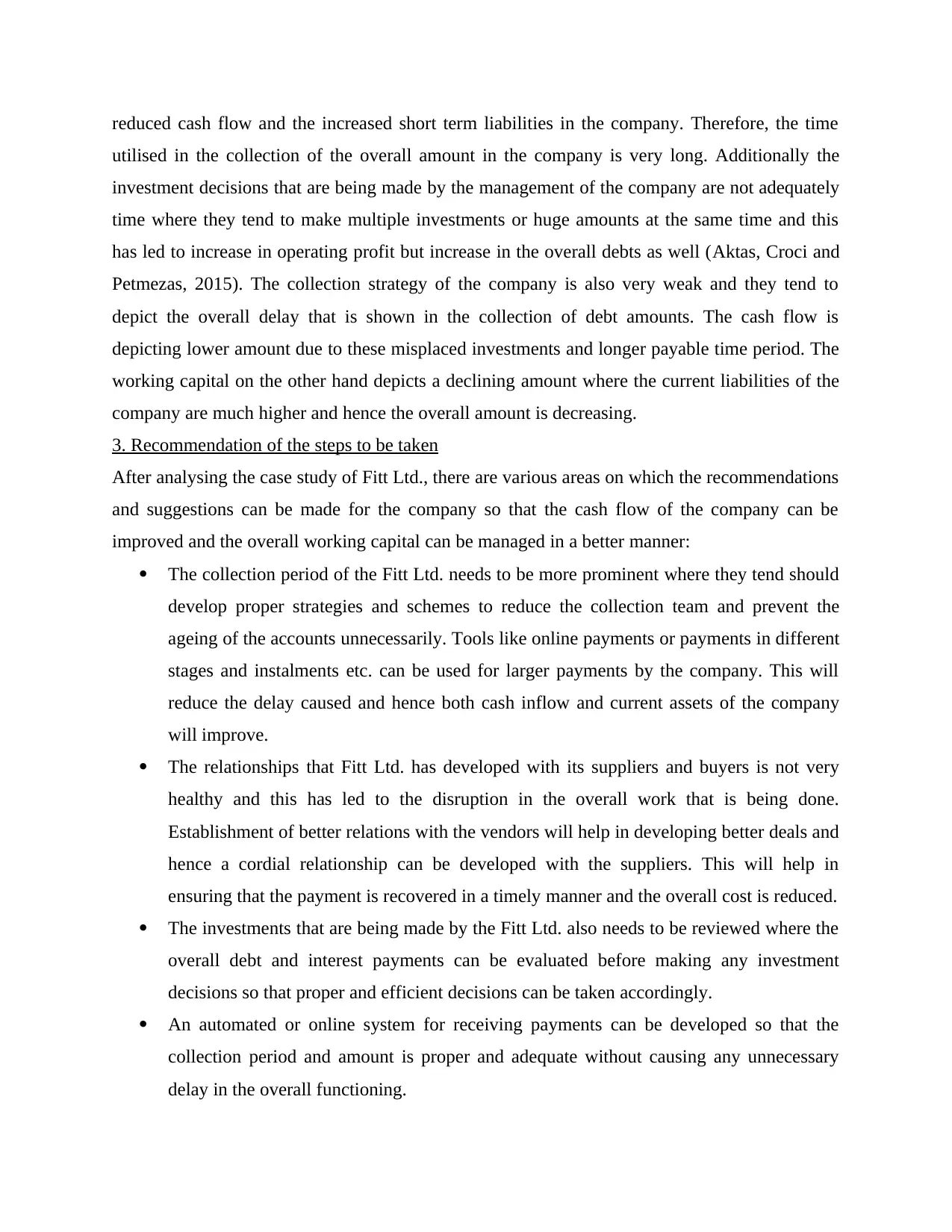
reduced cash flow and the increased short term liabilities in the company. Therefore, the time
utilised in the collection of the overall amount in the company is very long. Additionally the
investment decisions that are being made by the management of the company are not adequately
time where they tend to make multiple investments or huge amounts at the same time and this
has led to increase in operating profit but increase in the overall debts as well (Aktas, Croci and
Petmezas, 2015). The collection strategy of the company is also very weak and they tend to
depict the overall delay that is shown in the collection of debt amounts. The cash flow is
depicting lower amount due to these misplaced investments and longer payable time period. The
working capital on the other hand depicts a declining amount where the current liabilities of the
company are much higher and hence the overall amount is decreasing.
3. Recommendation of the steps to be taken
After analysing the case study of Fitt Ltd., there are various areas on which the recommendations
and suggestions can be made for the company so that the cash flow of the company can be
improved and the overall working capital can be managed in a better manner:
The collection period of the Fitt Ltd. needs to be more prominent where they tend should
develop proper strategies and schemes to reduce the collection team and prevent the
ageing of the accounts unnecessarily. Tools like online payments or payments in different
stages and instalments etc. can be used for larger payments by the company. This will
reduce the delay caused and hence both cash inflow and current assets of the company
will improve.
The relationships that Fitt Ltd. has developed with its suppliers and buyers is not very
healthy and this has led to the disruption in the overall work that is being done.
Establishment of better relations with the vendors will help in developing better deals and
hence a cordial relationship can be developed with the suppliers. This will help in
ensuring that the payment is recovered in a timely manner and the overall cost is reduced.
The investments that are being made by the Fitt Ltd. also needs to be reviewed where the
overall debt and interest payments can be evaluated before making any investment
decisions so that proper and efficient decisions can be taken accordingly.
An automated or online system for receiving payments can be developed so that the
collection period and amount is proper and adequate without causing any unnecessary
delay in the overall functioning.
utilised in the collection of the overall amount in the company is very long. Additionally the
investment decisions that are being made by the management of the company are not adequately
time where they tend to make multiple investments or huge amounts at the same time and this
has led to increase in operating profit but increase in the overall debts as well (Aktas, Croci and
Petmezas, 2015). The collection strategy of the company is also very weak and they tend to
depict the overall delay that is shown in the collection of debt amounts. The cash flow is
depicting lower amount due to these misplaced investments and longer payable time period. The
working capital on the other hand depicts a declining amount where the current liabilities of the
company are much higher and hence the overall amount is decreasing.
3. Recommendation of the steps to be taken
After analysing the case study of Fitt Ltd., there are various areas on which the recommendations
and suggestions can be made for the company so that the cash flow of the company can be
improved and the overall working capital can be managed in a better manner:
The collection period of the Fitt Ltd. needs to be more prominent where they tend should
develop proper strategies and schemes to reduce the collection team and prevent the
ageing of the accounts unnecessarily. Tools like online payments or payments in different
stages and instalments etc. can be used for larger payments by the company. This will
reduce the delay caused and hence both cash inflow and current assets of the company
will improve.
The relationships that Fitt Ltd. has developed with its suppliers and buyers is not very
healthy and this has led to the disruption in the overall work that is being done.
Establishment of better relations with the vendors will help in developing better deals and
hence a cordial relationship can be developed with the suppliers. This will help in
ensuring that the payment is recovered in a timely manner and the overall cost is reduced.
The investments that are being made by the Fitt Ltd. also needs to be reviewed where the
overall debt and interest payments can be evaluated before making any investment
decisions so that proper and efficient decisions can be taken accordingly.
An automated or online system for receiving payments can be developed so that the
collection period and amount is proper and adequate without causing any unnecessary
delay in the overall functioning.
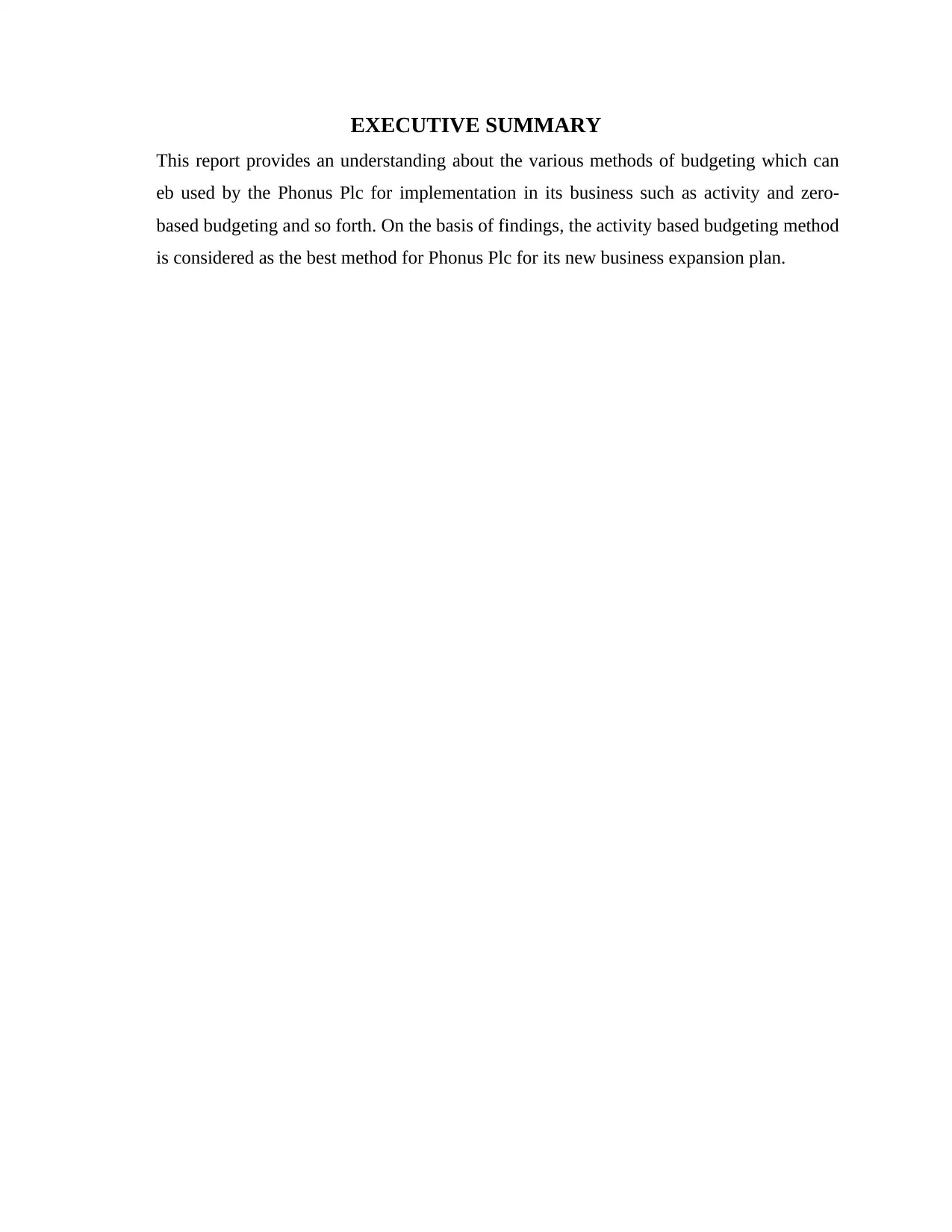
EXECUTIVE SUMMARY
This report provides an understanding about the various methods of budgeting which can
eb used by the Phonus Plc for implementation in its business such as activity and zero-
based budgeting and so forth. On the basis of findings, the activity based budgeting method
is considered as the best method for Phonus Plc for its new business expansion plan.
This report provides an understanding about the various methods of budgeting which can
eb used by the Phonus Plc for implementation in its business such as activity and zero-
based budgeting and so forth. On the basis of findings, the activity based budgeting method
is considered as the best method for Phonus Plc for its new business expansion plan.
Paraphrase This Document
Need a fresh take? Get an instant paraphrase of this document with our AI Paraphraser
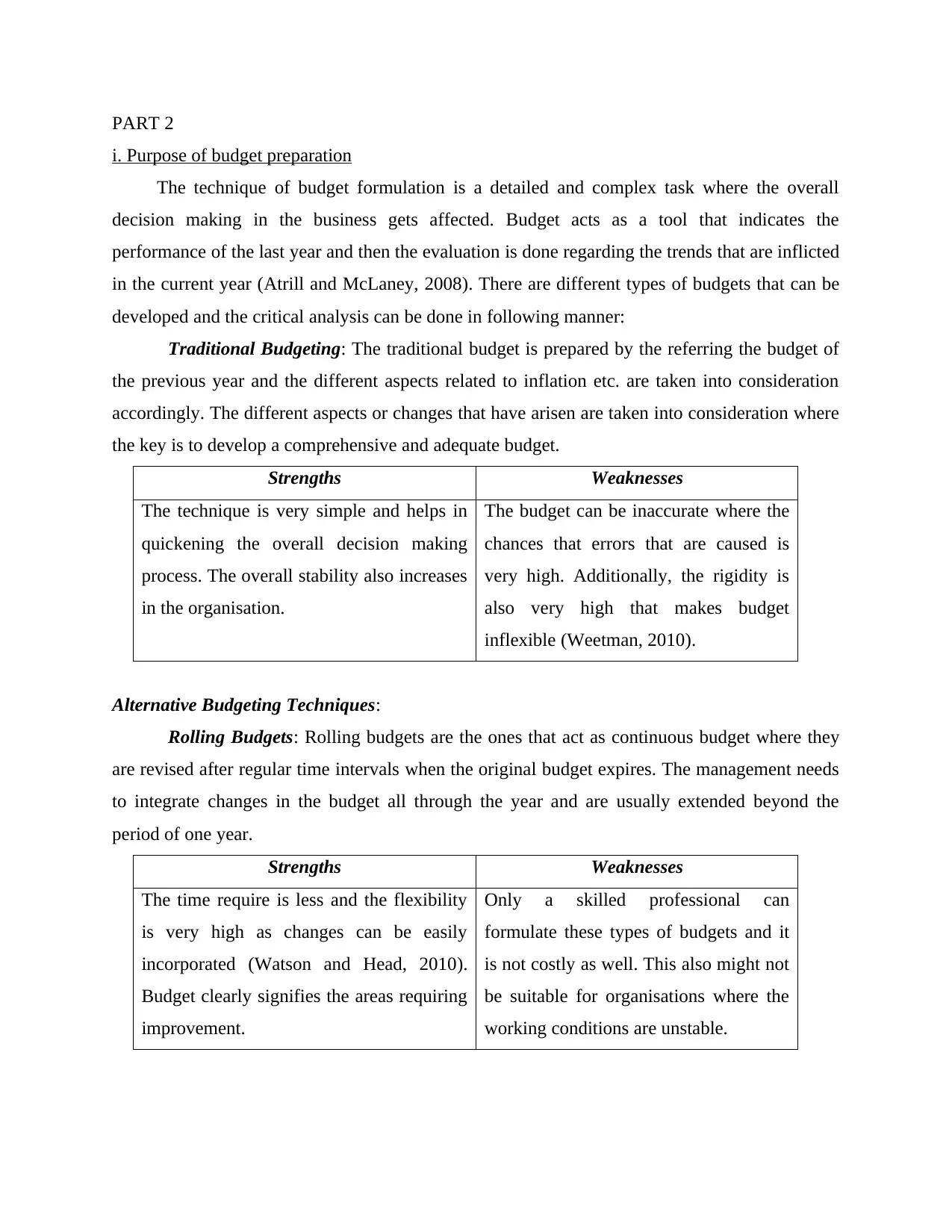
PART 2
i. Purpose of budget preparation
The technique of budget formulation is a detailed and complex task where the overall
decision making in the business gets affected. Budget acts as a tool that indicates the
performance of the last year and then the evaluation is done regarding the trends that are inflicted
in the current year (Atrill and McLaney, 2008). There are different types of budgets that can be
developed and the critical analysis can be done in following manner:
Traditional Budgeting: The traditional budget is prepared by the referring the budget of
the previous year and the different aspects related to inflation etc. are taken into consideration
accordingly. The different aspects or changes that have arisen are taken into consideration where
the key is to develop a comprehensive and adequate budget.
Strengths Weaknesses
The technique is very simple and helps in
quickening the overall decision making
process. The overall stability also increases
in the organisation.
The budget can be inaccurate where the
chances that errors that are caused is
very high. Additionally, the rigidity is
also very high that makes budget
inflexible (Weetman, 2010).
Alternative Budgeting Techniques:
Rolling Budgets: Rolling budgets are the ones that act as continuous budget where they
are revised after regular time intervals when the original budget expires. The management needs
to integrate changes in the budget all through the year and are usually extended beyond the
period of one year.
Strengths Weaknesses
The time require is less and the flexibility
is very high as changes can be easily
incorporated (Watson and Head, 2010).
Budget clearly signifies the areas requiring
improvement.
Only a skilled professional can
formulate these types of budgets and it
is not costly as well. This also might not
be suitable for organisations where the
working conditions are unstable.
i. Purpose of budget preparation
The technique of budget formulation is a detailed and complex task where the overall
decision making in the business gets affected. Budget acts as a tool that indicates the
performance of the last year and then the evaluation is done regarding the trends that are inflicted
in the current year (Atrill and McLaney, 2008). There are different types of budgets that can be
developed and the critical analysis can be done in following manner:
Traditional Budgeting: The traditional budget is prepared by the referring the budget of
the previous year and the different aspects related to inflation etc. are taken into consideration
accordingly. The different aspects or changes that have arisen are taken into consideration where
the key is to develop a comprehensive and adequate budget.
Strengths Weaknesses
The technique is very simple and helps in
quickening the overall decision making
process. The overall stability also increases
in the organisation.
The budget can be inaccurate where the
chances that errors that are caused is
very high. Additionally, the rigidity is
also very high that makes budget
inflexible (Weetman, 2010).
Alternative Budgeting Techniques:
Rolling Budgets: Rolling budgets are the ones that act as continuous budget where they
are revised after regular time intervals when the original budget expires. The management needs
to integrate changes in the budget all through the year and are usually extended beyond the
period of one year.
Strengths Weaknesses
The time require is less and the flexibility
is very high as changes can be easily
incorporated (Watson and Head, 2010).
Budget clearly signifies the areas requiring
improvement.
Only a skilled professional can
formulate these types of budgets and it
is not costly as well. This also might not
be suitable for organisations where the
working conditions are unstable.
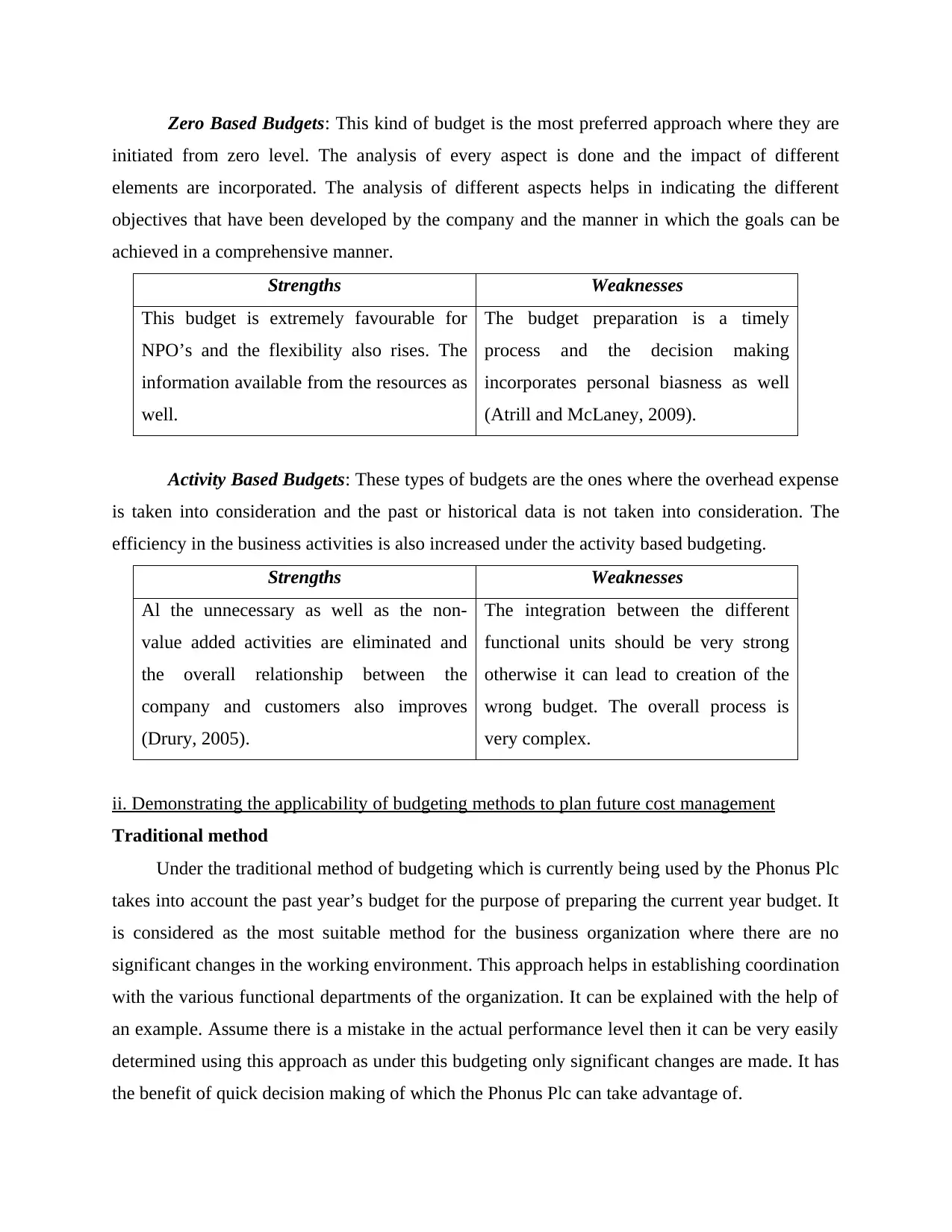
Zero Based Budgets: This kind of budget is the most preferred approach where they are
initiated from zero level. The analysis of every aspect is done and the impact of different
elements are incorporated. The analysis of different aspects helps in indicating the different
objectives that have been developed by the company and the manner in which the goals can be
achieved in a comprehensive manner.
Strengths Weaknesses
This budget is extremely favourable for
NPO’s and the flexibility also rises. The
information available from the resources as
well.
The budget preparation is a timely
process and the decision making
incorporates personal biasness as well
(Atrill and McLaney, 2009).
Activity Based Budgets: These types of budgets are the ones where the overhead expense
is taken into consideration and the past or historical data is not taken into consideration. The
efficiency in the business activities is also increased under the activity based budgeting.
Strengths Weaknesses
Al the unnecessary as well as the non-
value added activities are eliminated and
the overall relationship between the
company and customers also improves
(Drury, 2005).
The integration between the different
functional units should be very strong
otherwise it can lead to creation of the
wrong budget. The overall process is
very complex.
ii. Demonstrating the applicability of budgeting methods to plan future cost management
Traditional method
Under the traditional method of budgeting which is currently being used by the Phonus Plc
takes into account the past year’s budget for the purpose of preparing the current year budget. It
is considered as the most suitable method for the business organization where there are no
significant changes in the working environment. This approach helps in establishing coordination
with the various functional departments of the organization. It can be explained with the help of
an example. Assume there is a mistake in the actual performance level then it can be very easily
determined using this approach as under this budgeting only significant changes are made. It has
the benefit of quick decision making of which the Phonus Plc can take advantage of.
initiated from zero level. The analysis of every aspect is done and the impact of different
elements are incorporated. The analysis of different aspects helps in indicating the different
objectives that have been developed by the company and the manner in which the goals can be
achieved in a comprehensive manner.
Strengths Weaknesses
This budget is extremely favourable for
NPO’s and the flexibility also rises. The
information available from the resources as
well.
The budget preparation is a timely
process and the decision making
incorporates personal biasness as well
(Atrill and McLaney, 2009).
Activity Based Budgets: These types of budgets are the ones where the overhead expense
is taken into consideration and the past or historical data is not taken into consideration. The
efficiency in the business activities is also increased under the activity based budgeting.
Strengths Weaknesses
Al the unnecessary as well as the non-
value added activities are eliminated and
the overall relationship between the
company and customers also improves
(Drury, 2005).
The integration between the different
functional units should be very strong
otherwise it can lead to creation of the
wrong budget. The overall process is
very complex.
ii. Demonstrating the applicability of budgeting methods to plan future cost management
Traditional method
Under the traditional method of budgeting which is currently being used by the Phonus Plc
takes into account the past year’s budget for the purpose of preparing the current year budget. It
is considered as the most suitable method for the business organization where there are no
significant changes in the working environment. This approach helps in establishing coordination
with the various functional departments of the organization. It can be explained with the help of
an example. Assume there is a mistake in the actual performance level then it can be very easily
determined using this approach as under this budgeting only significant changes are made. It has
the benefit of quick decision making of which the Phonus Plc can take advantage of.
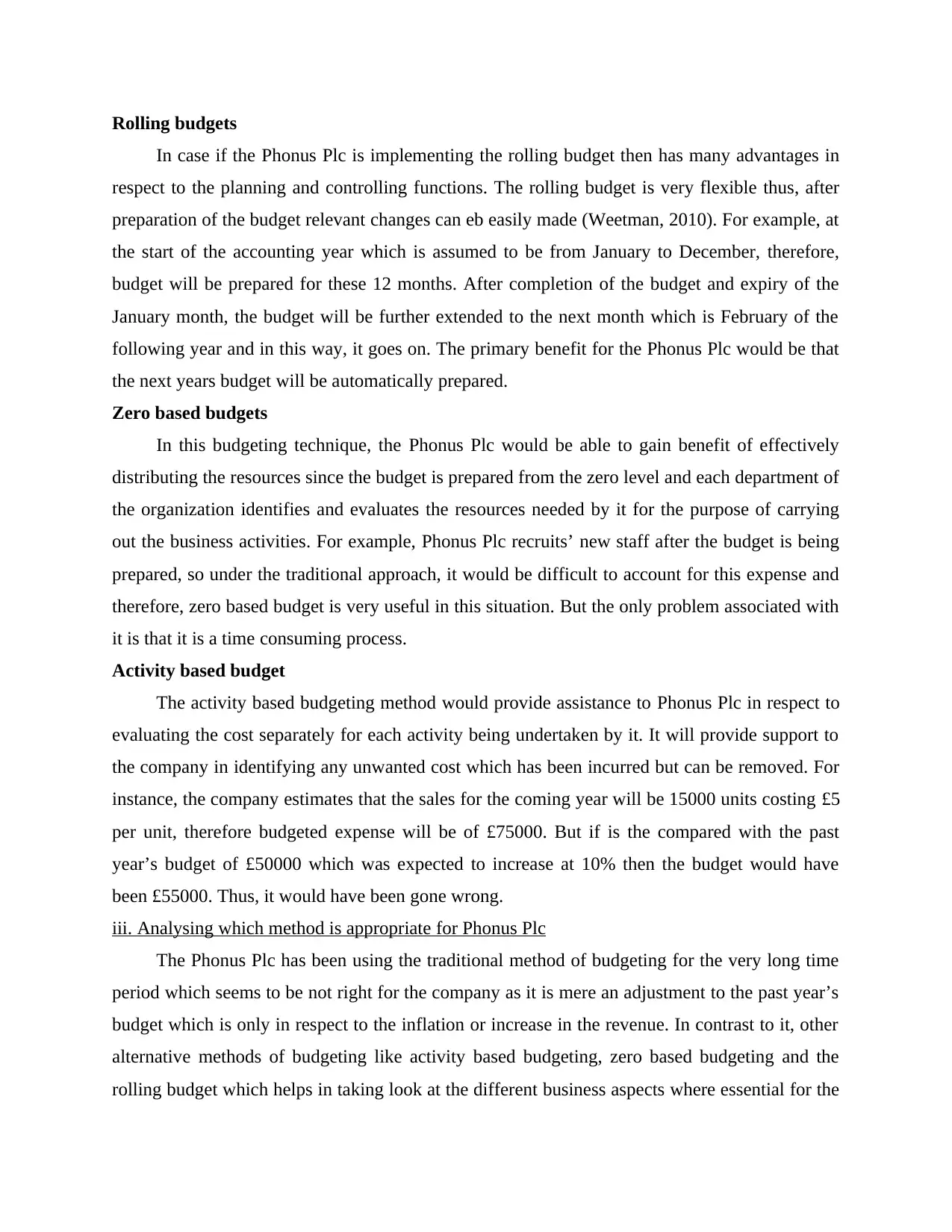
Rolling budgets
In case if the Phonus Plc is implementing the rolling budget then has many advantages in
respect to the planning and controlling functions. The rolling budget is very flexible thus, after
preparation of the budget relevant changes can eb easily made (Weetman, 2010). For example, at
the start of the accounting year which is assumed to be from January to December, therefore,
budget will be prepared for these 12 months. After completion of the budget and expiry of the
January month, the budget will be further extended to the next month which is February of the
following year and in this way, it goes on. The primary benefit for the Phonus Plc would be that
the next years budget will be automatically prepared.
Zero based budgets
In this budgeting technique, the Phonus Plc would be able to gain benefit of effectively
distributing the resources since the budget is prepared from the zero level and each department of
the organization identifies and evaluates the resources needed by it for the purpose of carrying
out the business activities. For example, Phonus Plc recruits’ new staff after the budget is being
prepared, so under the traditional approach, it would be difficult to account for this expense and
therefore, zero based budget is very useful in this situation. But the only problem associated with
it is that it is a time consuming process.
Activity based budget
The activity based budgeting method would provide assistance to Phonus Plc in respect to
evaluating the cost separately for each activity being undertaken by it. It will provide support to
the company in identifying any unwanted cost which has been incurred but can be removed. For
instance, the company estimates that the sales for the coming year will be 15000 units costing £5
per unit, therefore budgeted expense will be of £75000. But if is the compared with the past
year’s budget of £50000 which was expected to increase at 10% then the budget would have
been £55000. Thus, it would have been gone wrong.
iii. Analysing which method is appropriate for Phonus Plc
The Phonus Plc has been using the traditional method of budgeting for the very long time
period which seems to be not right for the company as it is mere an adjustment to the past year’s
budget which is only in respect to the inflation or increase in the revenue. In contrast to it, other
alternative methods of budgeting like activity based budgeting, zero based budgeting and the
rolling budget which helps in taking look at the different business aspects where essential for the
In case if the Phonus Plc is implementing the rolling budget then has many advantages in
respect to the planning and controlling functions. The rolling budget is very flexible thus, after
preparation of the budget relevant changes can eb easily made (Weetman, 2010). For example, at
the start of the accounting year which is assumed to be from January to December, therefore,
budget will be prepared for these 12 months. After completion of the budget and expiry of the
January month, the budget will be further extended to the next month which is February of the
following year and in this way, it goes on. The primary benefit for the Phonus Plc would be that
the next years budget will be automatically prepared.
Zero based budgets
In this budgeting technique, the Phonus Plc would be able to gain benefit of effectively
distributing the resources since the budget is prepared from the zero level and each department of
the organization identifies and evaluates the resources needed by it for the purpose of carrying
out the business activities. For example, Phonus Plc recruits’ new staff after the budget is being
prepared, so under the traditional approach, it would be difficult to account for this expense and
therefore, zero based budget is very useful in this situation. But the only problem associated with
it is that it is a time consuming process.
Activity based budget
The activity based budgeting method would provide assistance to Phonus Plc in respect to
evaluating the cost separately for each activity being undertaken by it. It will provide support to
the company in identifying any unwanted cost which has been incurred but can be removed. For
instance, the company estimates that the sales for the coming year will be 15000 units costing £5
per unit, therefore budgeted expense will be of £75000. But if is the compared with the past
year’s budget of £50000 which was expected to increase at 10% then the budget would have
been £55000. Thus, it would have been gone wrong.
iii. Analysing which method is appropriate for Phonus Plc
The Phonus Plc has been using the traditional method of budgeting for the very long time
period which seems to be not right for the company as it is mere an adjustment to the past year’s
budget which is only in respect to the inflation or increase in the revenue. In contrast to it, other
alternative methods of budgeting like activity based budgeting, zero based budgeting and the
rolling budget which helps in taking look at the different business aspects where essential for the
Secure Best Marks with AI Grader
Need help grading? Try our AI Grader for instant feedback on your assignments.
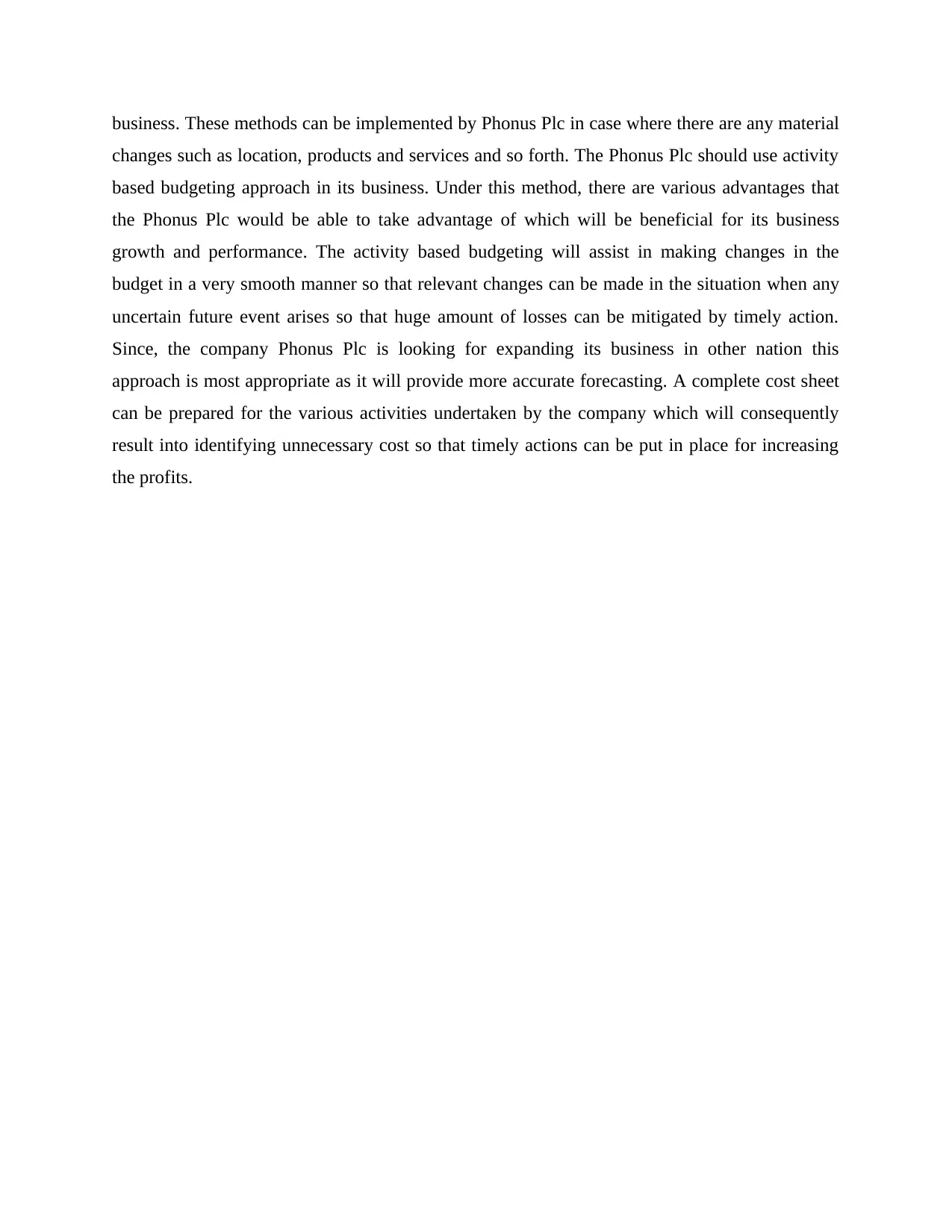
business. These methods can be implemented by Phonus Plc in case where there are any material
changes such as location, products and services and so forth. The Phonus Plc should use activity
based budgeting approach in its business. Under this method, there are various advantages that
the Phonus Plc would be able to take advantage of which will be beneficial for its business
growth and performance. The activity based budgeting will assist in making changes in the
budget in a very smooth manner so that relevant changes can be made in the situation when any
uncertain future event arises so that huge amount of losses can be mitigated by timely action.
Since, the company Phonus Plc is looking for expanding its business in other nation this
approach is most appropriate as it will provide more accurate forecasting. A complete cost sheet
can be prepared for the various activities undertaken by the company which will consequently
result into identifying unnecessary cost so that timely actions can be put in place for increasing
the profits.
changes such as location, products and services and so forth. The Phonus Plc should use activity
based budgeting approach in its business. Under this method, there are various advantages that
the Phonus Plc would be able to take advantage of which will be beneficial for its business
growth and performance. The activity based budgeting will assist in making changes in the
budget in a very smooth manner so that relevant changes can be made in the situation when any
uncertain future event arises so that huge amount of losses can be mitigated by timely action.
Since, the company Phonus Plc is looking for expanding its business in other nation this
approach is most appropriate as it will provide more accurate forecasting. A complete cost sheet
can be prepared for the various activities undertaken by the company which will consequently
result into identifying unnecessary cost so that timely actions can be put in place for increasing
the profits.

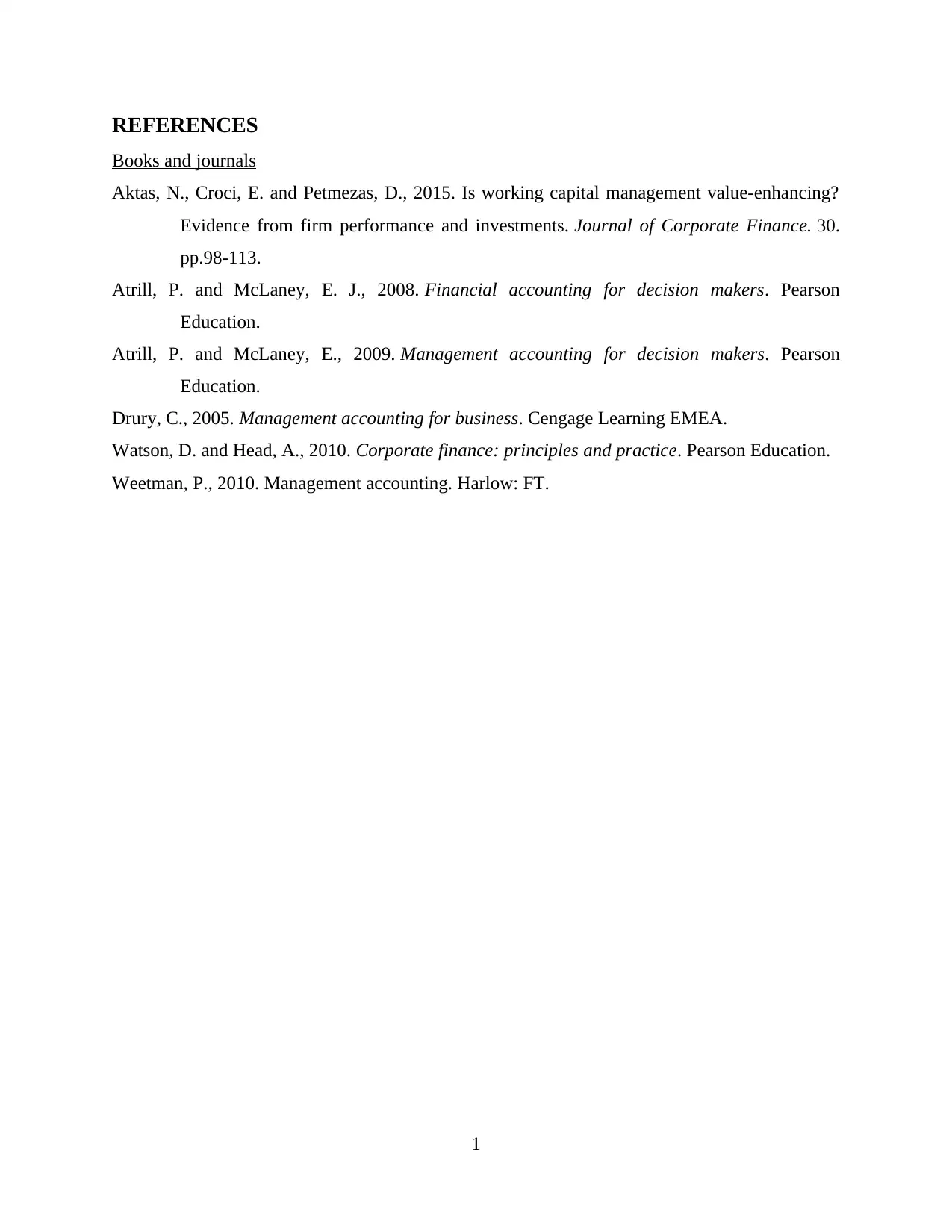
REFERENCES
Books and journals
Aktas, N., Croci, E. and Petmezas, D., 2015. Is working capital management value-enhancing?
Evidence from firm performance and investments. Journal of Corporate Finance. 30.
pp.98-113.
Atrill, P. and McLaney, E. J., 2008. Financial accounting for decision makers. Pearson
Education.
Atrill, P. and McLaney, E., 2009. Management accounting for decision makers. Pearson
Education.
Drury, C., 2005. Management accounting for business. Cengage Learning EMEA.
Watson, D. and Head, A., 2010. Corporate finance: principles and practice. Pearson Education.
Weetman, P., 2010. Management accounting. Harlow: FT.
1
Books and journals
Aktas, N., Croci, E. and Petmezas, D., 2015. Is working capital management value-enhancing?
Evidence from firm performance and investments. Journal of Corporate Finance. 30.
pp.98-113.
Atrill, P. and McLaney, E. J., 2008. Financial accounting for decision makers. Pearson
Education.
Atrill, P. and McLaney, E., 2009. Management accounting for decision makers. Pearson
Education.
Drury, C., 2005. Management accounting for business. Cengage Learning EMEA.
Watson, D. and Head, A., 2010. Corporate finance: principles and practice. Pearson Education.
Weetman, P., 2010. Management accounting. Harlow: FT.
1
1 out of 13
Related Documents
Your All-in-One AI-Powered Toolkit for Academic Success.
+13062052269
info@desklib.com
Available 24*7 on WhatsApp / Email
![[object Object]](/_next/static/media/star-bottom.7253800d.svg)
Unlock your academic potential
© 2024 | Zucol Services PVT LTD | All rights reserved.





